IBM rolls out first Cell-based blade server
Armonk (NY) - IBM announced availability of what the company calls the first "generally available" computer system with a Cell processor. While the CPU is best known as the power plant of Sony's upcoming Playstation 3 console, it is marketed as a viable resource in computing-intensive fields, such as the medical, defense, animation, aerospace and oil industries, as well.
Early versions of the QS20 have been already in place for some time in the United States, United Kingdom, Spain, Germany, France, Japan and Korea. Universities are part of the early adopter group, with some prestigeous schools like the University of Manchester integrating them throughout the campuses.
IBM will be offering the QS20 via the firm's System Cluster 1350. The system currently represents IBM's flagship Linux cluster. The QS20 houses two Cell (BE) 3.2 GHz processors and promises to deliver "supercomputer-like" performance, IBM claims.
IBM QS20
The Cell processor is based on IBM's Power architecture and integrates a Power Processing Element (PPE) and eight Synergistic Processing Elements (SPEs). The PPE is designed as a general purpose 64-bit RISC processor based on the PowerPC 2.02 chip and carries 64 kB L1 cache. Each SPE is described as a special purpose RISC processor with 128-bit SIMD (Single Instruction Multiple Data) capability and 256 kB local memory.
While Cell-based servers are beginning to surface, the mass-market application for the processor remains Sony's Playstation 3 video game system, which is set to launch in the U.S. on 17 November.
Pricing of the QS20 has not been announced.
Get Tom's Hardware's best news and in-depth reviews, straight to your inbox.
Related articles:
Mercury intros Cell accelerator board for PC workstations
Could 10 - 20% yields for Cell processors lead to problems for Sony PS3?

Mark Raby is a freelance writer for Tom's Hardware, covering a wide range of topics, from video game reviews to detailed analyses of computer processors.
